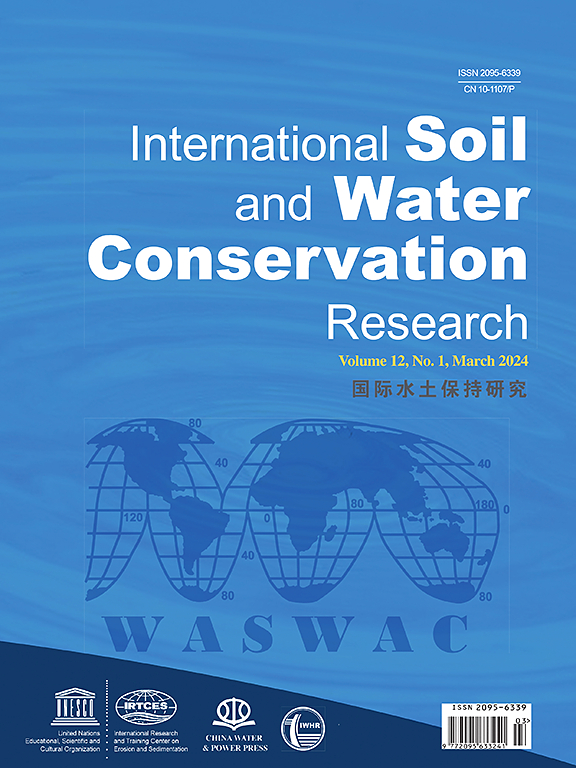Biochar application reduces soil detachment capacity by overland flow under a continuous three-year field experiment on the Loess Plateau of China
IF 7.3
1区 农林科学
Q1 ENVIRONMENTAL SCIENCES
International Soil and Water Conservation Research
Pub Date : 2025-04-17
DOI:10.1016/j.iswcr.2025.04.002
引用次数: 0
Abstract
Variation of soil properties induced by biochar amendments affects soil detachment capacity (Dc). However, the long-term effects of biochar on Dc have remained unexplored. This study assessed the variation of Dc with the rates and elapsed time since apple branch-derived biochar application, and quantified the relationship of Dc with hydrodynamic parameters and soil physicochemical properties in a three-year field experiment. Undisturbed soil samples to 20 cm depth were collected by using steel rings from field plots treated with biochar at 0, 24, 60, 96, 132, and 168 t ha−1 after biochar application for 1, 2 and 3 years. The Dc of these samples was evaluated through a flume experiment, with scouring soil samples under three flow discharge rates (0.00025, 0.00045, and 0.00065 m3 s−1) and five slope gradients (5.24, 8.75, 17.63, 26.79, and 40.40 %). Results revealed that, compared with no biochar treatment, the application of 24∼96 t ha−1 biochar after 1–2 years generally resulted in a reduction of Dc ranging from 6 %∼80 %, with a mean of 36 %. Conversely, 132 and 168 t ha−1 biochar application increased Dc by 59 % and 45 %. All biochar treatments after 3 years resulted in a 48 % reduction in Dc relative to bare soil. The Dc generally decreased with an increasing of rates and elapsed time since biochar application. The mean weight diameter of soil aggregates (MWD) and cohesion (COH) were the key indices influencing Dc in the first two years, while total organic carbon (TOC) started to significantly affect Dc in the last year. Shear stress (τ) emerged as the optimal hydrodynamic parameter for simulating Dc. Power function equations well estimated Dc using τ, MWD, COH, and TOC under biochar application. These results demonstrate that applying biochar with sufficient elapsed time since application and low rates, rather than minimal elapsed time since application and high rates leads to a greater enhancement of soil erosion resistance for loess soils, with potential to control rill erosion for degraded or degrading sloping farmland at risk of erosion on the Loess Plateau.

在黄土高原连续3年的田间试验中,生物炭的施用降低了地表径流对土壤的剥离能力
生物炭改性引起的土壤性质变化影响土壤剥离能力(Dc)。然而,生物炭对Dc的长期影响仍未得到探索。本研究通过3年的田间试验,评估了苹果枝源生物炭施用后土壤中直流电含量随施用速率和施用时间的变化,并定量分析了直流电含量与水动力参数和土壤理化性质的关系。在施用生物炭1、2和3年后,分别在0、24、60、96、132和168 t ha - 1处理过的地块上,采用钢环收集20 cm深度的原状土壤样品。在3种流量(0.00025、0.00045和0.00065 m3 s−1)和5种坡度(5.24、8.75、17.63、26.79和40.40%)条件下,通过水槽试验评估了冲刷土样品的Dc。结果表明,与没有生物炭处理相比,1 - 2年后施用24 ~ 96 tha - 1生物炭通常导致Dc降低6% ~ 80%,平均为36%。相反,施用132和168 t ha - 1生物炭可使Dc分别增加59%和45%。3年后,所有的生物炭处理导致Dc相对于裸土减少48%。自生物炭施用以来,Dc一般随速率和时间的增加而降低。土壤团聚体平均重径(MWD)和黏聚力(COH)是前2年影响土壤水分流变性的关键指标,而总有机碳(TOC)从去年开始显著影响土壤水分流变性。剪切应力(τ)是模拟直流的最佳水动力参数。在生物炭应用下,幂函数方程利用τ、MWD、COH和TOC很好地估计了Dc。这些结果表明,施用生物炭后,施用足够的时间和较低的施用量,而不是施用最短的时间和较高的施用量,可以更大程度地增强黄土土壤的抗侵蚀能力,并有可能控制黄土高原有侵蚀风险的退化或退化坡耕地的细沟侵蚀。
本文章由计算机程序翻译,如有差异,请以英文原文为准。
求助全文
约1分钟内获得全文
求助全文
来源期刊

International Soil and Water Conservation Research
Agricultural and Biological Sciences-Agronomy and Crop Science
CiteScore
12.00
自引率
3.10%
发文量
171
审稿时长
49 days
期刊介绍:
The International Soil and Water Conservation Research (ISWCR), the official journal of World Association of Soil and Water Conservation (WASWAC) http://www.waswac.org, is a multidisciplinary journal of soil and water conservation research, practice, policy, and perspectives. It aims to disseminate new knowledge and promote the practice of soil and water conservation.
The scope of International Soil and Water Conservation Research includes research, strategies, and technologies for prediction, prevention, and protection of soil and water resources. It deals with identification, characterization, and modeling; dynamic monitoring and evaluation; assessment and management of conservation practice and creation and implementation of quality standards.
Examples of appropriate topical areas include (but are not limited to):
• Conservation models, tools, and technologies
• Conservation agricultural
• Soil health resources, indicators, assessment, and management
• Land degradation
• Sustainable development
• Soil erosion and its control
• Soil erosion processes
• Water resources assessment and management
• Watershed management
• Soil erosion models
• Literature review on topics related soil and water conservation research
 求助内容:
求助内容: 应助结果提醒方式:
应助结果提醒方式:


